Prime Time
Biography
Trajal Harrell’s work has been presented at many venues including The Kitchen, Danspace Project, The New Museum, Dance Theater Workshop, P.S. 122, Institute of Contemporary Arts (ICA) Boston, The Margulies Art Warehouse (Miami), The Bronx Museum of the Arts, Art Basel Miami Beach, Dance Mission (San Francisco, CA), Cornell University’s Schwartz Center for the Performing Arts, Brooklyn Arts Exchange (BAX), Snug Harbor Cultural Center, and CUNY’s Martin Segal Theater and Proshansky Auditorium, among others. Internationally, his work has toured to international festivals in France, Austria, the Netherlands, Belgium, Germany, Poland, Croatia, and Mexico.
His first full-evening length work Notes on Less Than Zero premiered at Danspace Project in June 2004 followed by Before Intermission, a half-evening creation, which premiered at The Kitchen in February 2006. Showpony, premiered at Danspace Project in January 2007. In 2008, he created Quartet for the End of Time. This work takes the story of Olivier Messiaen’s famous music of the same name (composed and first performed by Jewish and Christian musicians in a Nazi prisoner-of-war camp) as a foundation for investigating the antagonism between sincerity and irony in contemporary expression, behavior, and stage representation. Quartet for the End of Time premiered October 2008 at Dance Theater Workshop and was chosen by TimeOut New York Magazine as one of the best dances of 2008.
During the fall of 2009, he premiered the first work in a new series entitled Twenty Looks or Paris is Burning at The Judson Church at The New Museum, co-presented by Danspace Project and Crossing the Line Festival. This work, Twenty Looks or Paris is Burning at The Judson Church (S), has also been shown in international festivals and at The Institute of Contemporary Arts Boston in partnership with Summer Stages Dance/Concord Academy. It was also chosen by Time Out New York Magazine as one of the best dances of 2009. Most recently, he premiered Twenty Looks or Paris is Burning at The Judson Church (M) aka (M)imosa and Twenty Looks…(XS) at The Kitchen in February 2011.
He has received grant support from the Jerome Foundation, the Map Fund, the Alfred Meyer Foundation, U.S. Artists International, Mary Duke Biddle Foundation, Foundation for Contemporary Arts, FUSED (French-US Exchange in Dance), Trust for Mutual Understanding, and NYC Department of Cultural Affairs, among others.
Artist Statement
I was stunned to find out that voguing and Judson era postmodern dance starting around the same historical time in the 1960’s—one downtown in Greenwich Village and one uptown in Harlem. Therefore since 2001, my work has been imagining that the two actually came together in dialogue to question and reflect together both politically and aesthetically By hosting this conversation on the architectural stage space of the fashion runway (an ode to both traditions’use of pedestrianism), I have tried to invent performative strategies oscillating between voguing’s “realness” and early postmodernism’s “authenticity.” Of course, dance history as it has been written speaks about Judson but not voguing, as Gérard Mayen has written: “Judson reunited middle and upper-middle class artists and audiences, white and culturally selective, politicized, and convinced of the democratic scope of their privilege for an everyday gesture and body – one that was neutral and full of ‘authenticity.’ The voguing ballrooms brought together poorer artists and audiences, non-white, inspired by pop and fashion culture and a search for the ‘realness’ of gesture.” This realness turns out to reveal the artificiality being performed at the root of all social identities. I am most interested in how the imagination can re-think the “omissions” of history. In this way, performance can be a way in which we collectively reimagine the impossibilities of history and thus make room for new possibilities in the world we make today.

